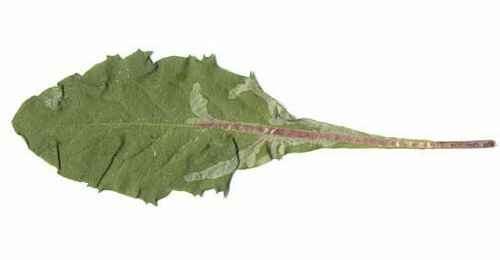|
||||||
|
Ophiomyia pulicaria (Meigen, 1830) Agromyza
pulicaria Meigen, 1830. Syst. Beschr. 6: 170 |
|||||||||||||||||||||||||||||||||||||||||||||||||||||||||||||||||||||||||||||||||||||||||||
Leaf-miner: A whitish blotch-mine along the mid-rib, with lateral offshoots into the leaf blade. Pupation at base of leaf in petiole (Spencer, 1972b: 25). Broad corridor overlying the midrib, with short excursion into the blade, mainly in its basal part. Frass concentrated in the basal part of the mine, corridors almost free from frass. Pupation in the mine, also in the basal part (Bladmineerders van Europa).
Larva: The larvae of flies are leg-less maggots without a head capsule (see examples). They never have thoracic or abdominal legs. They do not have chewing mouthparts, although they do have a characteristic cephalo-pharyngeal skeleton (see examples), usually visible internally through the body wall. The larva is described by de Meijere (1928) and Sasakawa (1961). Posterior spiracles on short stalks, each with an ellipse of 11-14 bulbs (Spencer, 1972b: 25). Puparium: The puparia of flies are formed within the hardened last larval skin or puparium and as a result sheaths enclosing head appendages, wings and legs are not visible externally (see examples). Pale, whitish-yellow (Spencer, 1972: 25). Comments: Leontodon autumnalis is treated as Scorzoneroides autumnalis (Autumn Hawkbit) by Stace (2010). Hosts in Great Britain and Ireland:
Hosts elsewhere: Time of year - mines: May, July. Time of year - adults: There are at least two generations per year. Distribution in Great Britain and Ireland: Widespread and common in Britain, including Lancashire (Formby) (Spencer, 1972b: 25) and Warwickshire (Robbins, 1991: 124); Cambridgeshire, East Suffolk, Glamorgan, North Somerset, South-west Yorkshire and West Gloucestershire (NBN Atlas). Distribution elsewhere: Widespread in continental Europe including Denmark, Finland, Norway (Spencer, 1976: 75), The Netherlands (Bladmineerders van Europa), Belgium (de Bruyn and von Tschirnhaus, 1991), Germany (Spencer, 1976: 75), Austria, Canary Is., Corsica, Croatia, Czech Republic, Estonia, European Turkey, French mainland, Hungary, Italian mainland, Lithuania, Poland, Slovakia, Spanish mainland, Switzerland and Yugoslavia (Fauna Europaea). Range extending east to Siberia (Spencer, 1976: 75). Also recorded from Canada (Spencer, 1969a: 93; Spencer, 1976: 75). NBN Atlas links to known host species: British and Irish Parasitoids in Britain and elsewhere:
|
|
|
|
| External links: | Search the internet: |
| Biodiversity Heritage Library Bladmineerders van Europa British leafminers Encyclopedia of Life Fauna Europaea NBN Atlas NHM UK Checklist |
Find
using Google Find using Google Scholar Find images using Google |
| Last 10-Jul-2019 Brian Pitkin | ||

